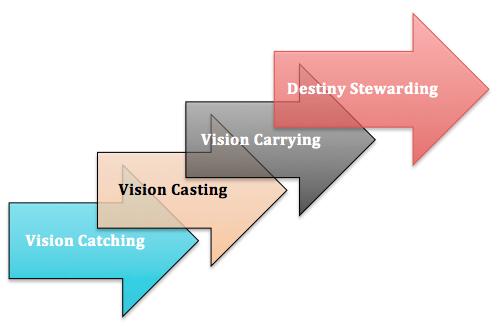
The Four Stages of Visionary Leadership
I have reflected over a decade on the question of how visionaries develop. These are some initial thoughts that I want to share with blog readers as I think out loud a bit. I would really appreciate your comments and input toward the development of these ideas.
Stage One: VISION CATCHING
Every visionary leaders starts by following someone else’s vision. Here, the fundamental practice of following well precedes and develops the ability to lead well. During this time, a future visionary learns to submit to godly authority. In this stage the future visionary’s style is shaped by the strengths and limitation of the lead visionary. Strengths provide a foundational modeling opportunity. Limitations and weakness forge convictions that will eventually shape the values of the future leader.
Stage Two VISION CASTING
Eventually the visionary leader starts casting vision themselves. There are three nuances of how this vision relates to the the prior vision-catching content. In other words, most of early vision casting is found “underneath” the vision of a leader and/or organization of the developing visionary. The visionary casts vision: a) in support of, b) in relation to, and finally c) in contrast with.
- In Support Of: The first practice is recasting the vision that already exists. The visionary is articulating and communicating what was given to them. The art of communication is matured as commitment, passion and ownership of the vision progresses. For example, a student pastor shares the greater vision of the church he has been serving for the last two years with his seminary buddies.
- In Relation To: Eventually the emerging visionary will create and develop their own initiatives or ministry models within the larger vision. This mini-step takes the art of visionary leadership to a new level. As a visionary leader “builds” within their “domain” of the larger ministry they are responsible to relate what they are doing to the bigger picture. That is, they are advancing and enhancing the vision that they “caught” by casting new vision for their team, event, group, area or department. Our student pastor, for example, is recruiting two dozen new volunteer leaders for a high-school, gospel saturation strategy he developed. This strategy and mini-vision is developed in concert with the broader church vision.
- In Contrast With: This is the positive step of beginning to sense a shift in calling or being attracted to a new ministry vehicle. While this is not an eventual reality for all visionary leaders it will happen for many of them. And by the way, it’s difficult for many senior leaders to watch this happen without sensing betrayal or hurt. This is normal. Yet from God’s perspective, isn’t it natural that a strong emerging visionary will develop completely a new “holy discontent?” Won’t he see new problems and want to find new solutions? The term “in contrast with” is helpful because oftentimes in the mind of the developing visionary, the language of the new is contrasted with and compared to the existing vision. (Hence we talk about missional vs. attractional approaches or going to unreached people groups vs. growing an existing flock.) For example the student pastor starts dreaming of planting a different kind of church in contrast with the vision he has been serving in.
Stage Three: VISION CARRYING
At this pivotal place, the vision casting stage has matured to a point of full ownership, most often embodied by the senior position or lead role. Hence, not every visionary leaders reaches this point. And it is wrong, in my opinion, to expect that all visionary leaders should aspire to. (Or we would have not visionary second-chair leaders or visionary teams.)
The greatest experiential difference for the vision carrier is the increasing awareness that the vision came from God not himself. Over time, a greater convergence of spiritual maturity, life circumstances, and divine relationships unveil how little the vision truly emerged from within. Eventually he sees how God was orchestrating the events of life to the point that he knows that God himself gave him a vision to carry. Of course his practice of vision-casting hits full-bloom as the vision grows and expands from an ever-strengthening identity and awareness of God calling.
Stage Four: DESTINY STEWARDING
The final stage is one that fewer leaders reach because it is found only with unusual favor AND demonstrated success as a vision carrier over a long time. The success builds a platform of extraordinary influence beyond what was ever imagined. Hence, I believe this stage is experience by leaders in or after their fifties. The feeling of “carrying” a vision for a time, which is in itself a stewardship, moves to an even greater awareness of unplanned, yet God-ordained impact. For the best leaders, this enables them to guard a humble spirit and embrace a broader influence. For example the student pastor plants a church that becomes a church planting movement, or or transforms a city or adopts an unreached people group. At this stage, decades of vision carrying are seen from a different and more enlightened perspective.
At this stage it’s easy for current names to come to mind like Rick Warren or Bill Hybels or T.D. Jakes or Mark Driscoll or Andy Stanley. But I believe there are thousands and thousands of leaders who reach this point, that we will never read about. Despite tremendous impact, they steward a more silent destiny.
So how do you react to this initial framing of these stages? Specifically how does this match up to your personal experience? What would you add or tweak or take away? Thanks for considering a response.
Read more from Will here.














